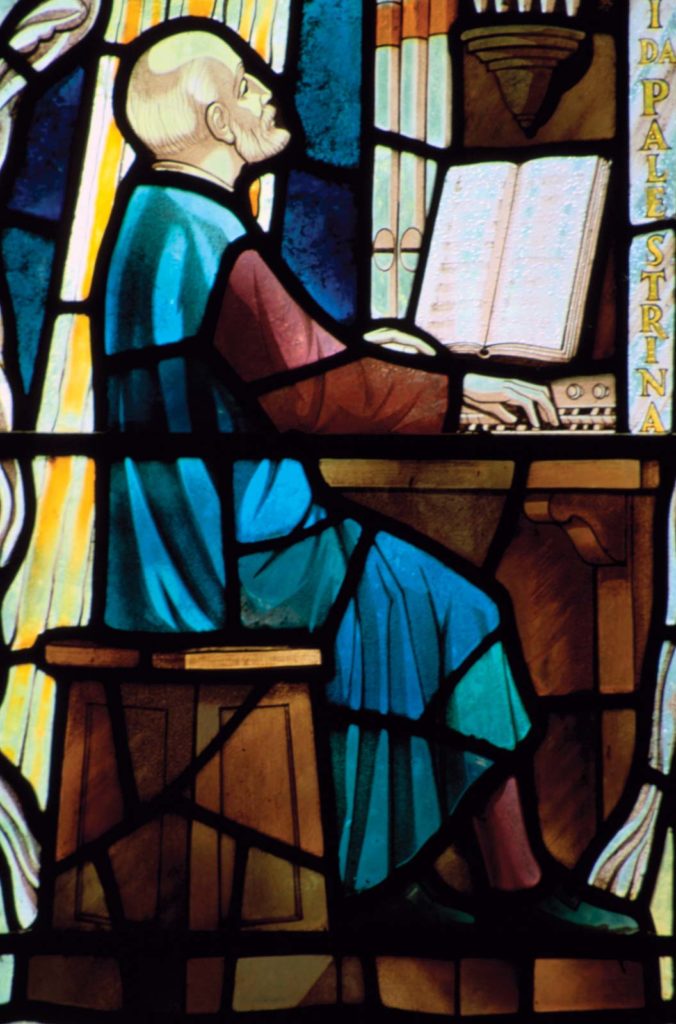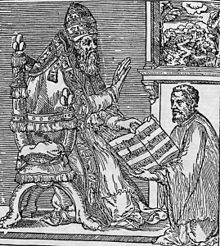
Giovanni Palestrina’s Studies & Early Work
I believe that I was born circa February 1525. It is impossible to confirm as the war between Emperor Charles V and Pope Clement VII destroyed my municipality of Palestrina along with many of its records. Documents recording the births and deaths of the previous decades were lost.
After my mother’s death, when I was only ten years old, I had the opportunity to visit Rome for the first time in 1537. It was impossible to tell then, but Rome became the hub of my creativity as a young adult and then my home as a career composer.
At the time, I had been working as a choirboy at the church of Santa Maria Maggiore. Thanks to the position, I was able to study literature and music, and it later gave me a leg up I needed to begin an earnest education in composition and music under the tutelage of Robin Mallapert and Firmin Lebel.
Church music had evolved, to some extent, from Plainsong, or Plainchant, also known as Gregorian Chant, into polyphony – many voices – over the past few centuries. My studies included learning the works of the prominent Netherlands composers Guillaume Dufay and Josquin des Prez.
In 1544, I became the cathedral organist at the main cathedral in Palestrina. The pay was substantial enough that I could set some money aside to finance my growing future. At the cathedral, I mainly played the organ and helped with the choir, and sometimes I taught music to disadvantaged students. During my time at the cathedral, I attracted the attention of the Bishop of Palestrina, who became Pope Julius III.
“Worldy cares of any kind…are adverse to the Muses, and particularly those which arise from a lack of private means. For, when the latter afford a sufficiency (and to aks more is the mark of a greedy and intemperate man), the mind can more easily detach itself from other cares; if not, the fault lies within. Those who have known the necessity of laboring to provide this sufficiency, according to their station and way of life, know full well how it distracts the mind from learning and from a study of the liberal arts. Certainly, I have known this experience all my life, and more especially in the present (1588). Yet I thank the Divine Goodness, first, that the course is now almost finished, and the goal in sight; secondly, that in the midst of the greatest difficulties I have never interrupted my study of music. Dedicated to the profession since boyhood and other interest could I have had? Would that my progress has equaled my labor and my diligence! I have composed and published much; a great deal more is lying by me, which I am hindered from publishing because of the straitened means of which I have spoken.”

Palestrina’s Marriage and Appointment to Musical Director of the Julian Choir
The future Pope Julius III and I became good friends. After I married Lucrezia Gori in 1547, he invited me to Rome and appointed me as the Julian Choir musical director. It was an important role, as I was directly responsible for all the music performed in the Vatican’s St. Peter’s Cathedral.
The leadership role also enabled me to become more creative with my compositions. In 1554, I published my first book of masses. I dedicated them to Pope Julius III, who, in return, made me a member of the pontifical choir. Ultimately, this appointment caused a rift with some of the other members, as I had not trained in voice, nor did I hold the standard qualifications showing that I was good enough to sing.
In 1555, I was appointed the musical director of St. John Lateran, where I was able to finish another publication titled Magnificats and Lamentations.

Giovanni Pierluigi Palestrina Composes Missa Papae Marcelli
Next, I completed Missa Papae Marcelli, which became my most well-known mass. Composed in honor of Pope Marcellus II, it became a point of debate regarding continuing or banning polyphonic music in the Catholic Church. After lengthy discussions, the church announced that my music was too beautiful to ban.
Summing this controversy up shortly after my death in 1607, composer Agostino Agazzari wrote:
“Music of the older kind is no longer in use, both because of the confusion and babel of the words, arising from the long and intricate imitations, and because it has no grace, for with all the voices singing, one hears neither period nor sense, these being interfered with and covered up by imitations… And on this account music would have come very near to being banished from the Holy Church by a sovereign pontiff (Pius IV), had not Giovanni Palestrina founded the remedy, showing that the fault and error lay, not with the music, but with the composers, and composing in confirmation of this the Mass entitled Missa Papae Marcelli.”
After allowing polyphonic music in the Catholic Church, I was honored as the savior of polyphony. A rumor began to circulate that the church had accepted my music.

Palestrina Supported by the Patron Cardinal Ippolito d’Este
In 1567, I left Santa Maria Maggiore for good and joined, instead, Cardinal Ippolito d’Este. Known as the patron of the Villa d’Este in Tivoli, I came to know him as a friend. He pushed me to write more music, and for five years, I composed several versions of the Improperia and Lamentations.
With the help and support from Ippolito d’Este, the works I composed at that time became some of my most popular and well-known pieces. In November of 1567, I was offered a position as a maestro by Emperor Maximillian II at the imperial chapel. However, after much discussion surrounding my salary, the Emperor decided to appoint Philippe de Monte, who asked one hundred scudi less than I did.
I published my second volume of masses in 1567 and dedicated it to Phillip II of Spain. It was in that volume that I began to emphasize my new style of music composition.
A year later, in 1568, I began corresponding with Duke Guglielmo Gonzaga of Mantua, a prominent music patron. Over the twenty years of correspondence, I found that these were the years I was at my most productive. I published several books on music and motets as well as many motets. The majority of my compositions were written during that time.
The books varied in subjects, from spiritual madrigals to motets, at one point even denouncing profanity in secular music, only to then follow it up with a new volume containing only profane (secular non-religious texts ) — Song of Songs, and Song of Songs Vol. II.
After the Duke commissioned me to write new works for private use in his chapel, I wrote to him: “I beg you to let me know how you prefer it: whether long or short or composed so that the words may be understood.”
In those works, I had used the “alternatim” technique for the first time, in which I blended my polyphonic sections with the Mantuan liturgy. In 1571, another volume of motets was published, with a dedication to Dule Guglielmo Gonzaga, and it included the blending technique of Mantuan liturgies.

Palestrina Returns to St. Peters Sistine Chapel
In 1571, I went back to my old appointment as maestro di cappella at the Sistine Chapel. During political strife in Italy, it was my most comfortable job, with enough money to get my family and me by and security in a house given to us by the church. During the procession held in Rome at the end of 1571 my madrigal Le selv’avea was played for the event, marking Italy’s victory at Lepanto.

Giovanni Palestrina Suffers Family Tragedies
The beginning of the 1580s marked a long list of personal tragedies in my family. My wife, Lucrezia, passed away suddenly on August 2, with my two sons closely following each other in death.
In those darkest, grief-filled moments of my life, I tried to assuage my pain by joining the priesthood. I petitioned Pope Gregory XIII, who sent my orders shortly after receiving my request letter, and on January 18, 1581, I was made chierico perpetuo beneficiato at the Santa Maria Maggiore.
Yet, I could not shake the realization that my life’s work was to compose music. I did an about-face, and in March 1581, I married Virginia Dormoli. The marriage finally gave me the financial security I had been looking for my entire life.
As the widow of a wealthy merchant, Virginia’s monetary worth was more than enough to provide us with a comfortable life. It was very typical at the time — if not expected— to marry for financial security. I continued to write music books.
“Nothing… is so congenial to me, as to be able to give myself to that study of music… when I can abide by my purpose of embracing topics which most fully show forth God’s praise, and which, pondered in all their weightiness and dignity of word and idea, and embellished with some amount of musical art, may well move the heart of man to devotion.”

Death and Influence of Giovanni Palestrina
The last anthology I published was in 1594, and on February 2, 1594, I died from pleurisy. It was noted in the chapel, “Giovanni da Palestrina died February 2 and was buried in our basilica… Wednesday on the 2nd. This morning Sig. Giovanni Pierloisci, the most excellent musician our colleague and master of the Chapel in St. Peter’s, passed from this life to a better one… at twenty-four hours he was borne to said church, accompanied not only by all the musicians of Rome but also by a multitude of people and, according to our custom, in accord with our constitution, we sang the responsory Libera me Domine…”
My surviving heirs buried me along with my first wife and my two sons Rodolfo and Angelo.
Yet my death did not stop my popularity. I left behind a considerable influence on Renaissance music, so much so that many composers that came after me felt inspired by my life’s work and music. I had left behind guidelines such as how to write music fluidly, so it sounds less static. Charles Gounod, heavily inspired by my music and polyphony, never hid that I heavily influenced him.
Please find compelling quotes of Giovanni Palestrina here on his quotes page.
SOURCES:
- The Lives of the Great Composers by Harold C. Schonberg
- Great Composers 1300-1900 by David Ewan
- Famous Composers by Nathan H Dole
- The Sacred Music of Giovanni Pierluigi de Palestrina: https://cmcomposerstudy.wordpress.com/2015/07/17/cm-composer-study/
- Music in the Culture of the Renaissance: https://www.jstor.org/stable/2707674?read-now=1&refreqid=excelsior%3A2462f88e32e5e352f432c83fd9148915&seq=2#page_scan_tab_contents
- Guglielmo Gonzaga and Palestrina’s Missa Dominicalis: https://academic.oup.com/mq/article-abstract/XXXIII/2/228/1076280?redirectedFrom=PDF
- Giovanni Pierluigi da Palestrina: https://www.britannica.com/biography/Giovanni-Pierluigi-da-Palestrina